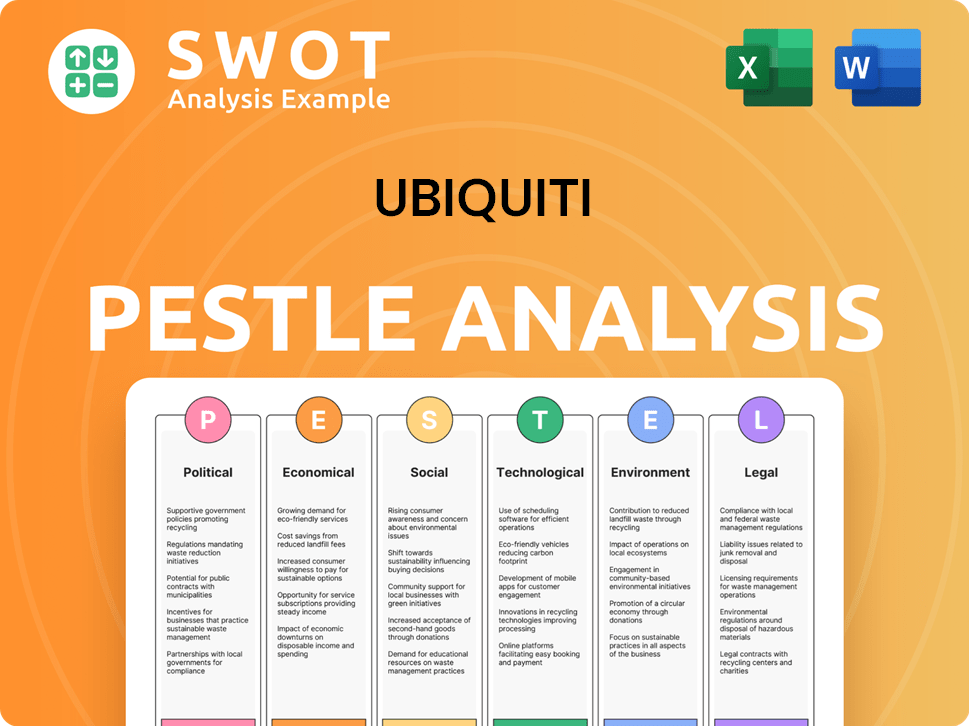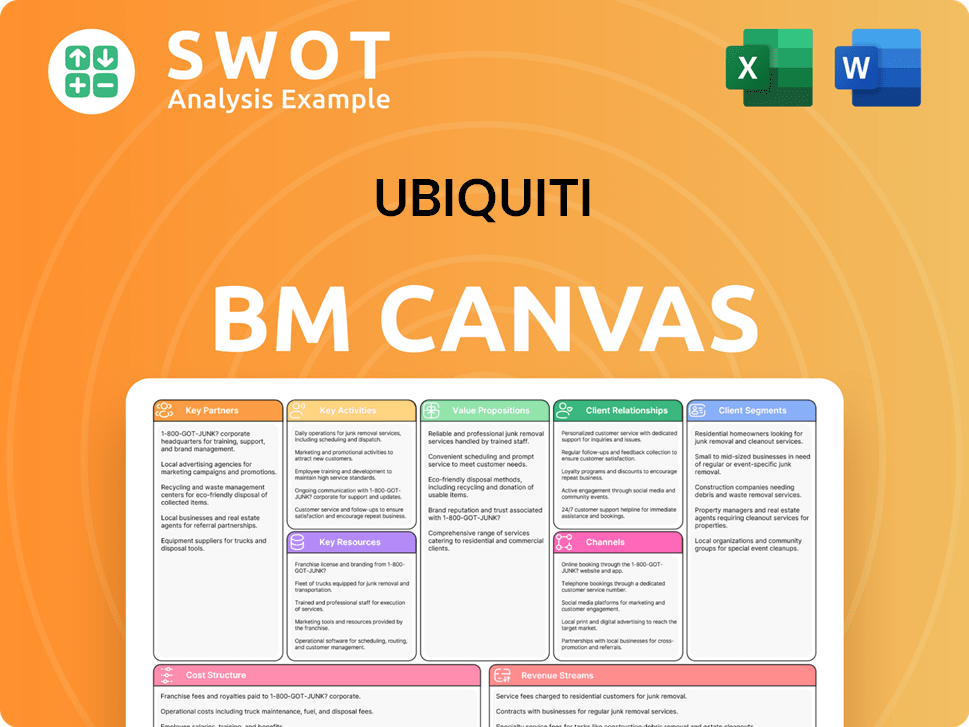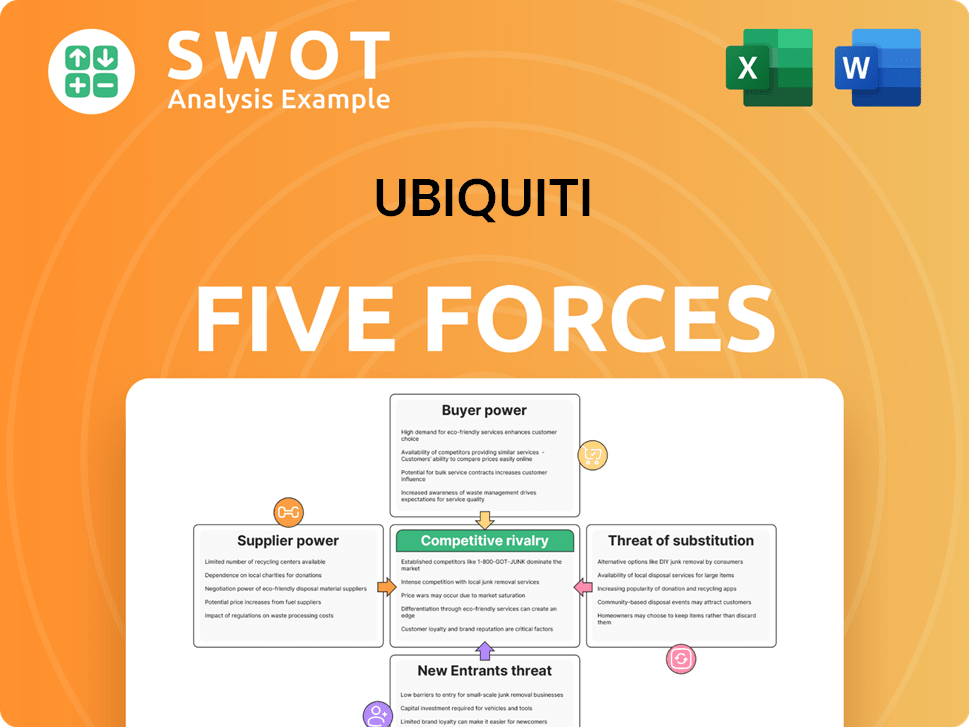Ubiquiti Bundle
How Does Ubiquiti Stack Up in the Networking World?
Ubiquiti Inc. has disrupted the networking hardware market with its cost-effective and community-driven approach. Founded in 2005, the company initially aimed to provide affordable wireless internet access, a mission that still drives its growth. This focus has allowed Ubiquiti to challenge established players in the industry, building a strong brand presence through innovative products and direct-to-consumer sales.

Understanding the Ubiquiti SWOT Analysis is crucial to grasp the Ubiquiti competitive landscape. This analysis will explore Ubiquiti's key strengths and weaknesses within the wireless networking industry, identifying its primary competitors and assessing its market positioning strategy. We'll delve into how Ubiquiti differentiates itself and what challenges it faces in this dynamic environment, including a detailed Ubiquiti market analysis.
Where Does Ubiquiti’ Stand in the Current Market?
Ubiquiti holds a distinctive market position within the networking industry, often viewed as a 'disruptor.' This is due to its strategy of offering prosumer-grade features at competitive price points. The company's focus on wireless networking and enterprise Wi-Fi has allowed it to gain ground, challenging traditional leaders with its UniFi ecosystem.
The company's primary product lines include UniFi (enterprise Wi-Fi, switching, routing, and surveillance), airMAX (wireless broadband for service providers), EdgeMAX (wired routing and switching), and UFiber (fiber broadband solutions). Ubiquiti's strong global presence serves a wide array of customers, from small and medium-sized businesses (SMBs) and enterprises to internet service providers (ISPs) and smart home users. Its market analysis reveals a strategic shift from wireless ISPs to broader enterprise and prosumer markets, diversifying revenue streams.
Financially, Ubiquiti has demonstrated robust health, often reporting strong revenue growth and profitability. For its fiscal year 2024, Ubiquiti reported a revenue of $1.86 billion. This financial scale, coupled with its lean operational model, positions Ubiquiti favorably against many industry averages. The company holds a particularly strong position in markets valuing cost-effectiveness, ease of deployment, and a strong community support model, while it may face more intense competition in highly regulated or large-scale enterprise environments demanding extensive professional services.
Ubiquiti's core operations revolve around designing, manufacturing, and selling networking hardware and software. This includes a wide range of products, from Wi-Fi access points to routing and switching equipment. The company's focus is on providing high-performance, easy-to-deploy solutions for various market segments.
The value proposition of Ubiquiti centers on offering high-quality, feature-rich networking products at competitive prices. This approach allows them to attract a broad customer base, from small businesses to large enterprises. Ubiquiti also emphasizes ease of use and a strong community support system.
Ubiquiti has steadily increased its market share in the networking hardware market, particularly in the enterprise WLAN segment. While specific figures fluctuate, Ubiquiti consistently ranks among the top contenders. The company's growth is driven by its competitive pricing and focus on user-friendly products.
Ubiquiti's target audience includes small and medium-sized businesses (SMBs), enterprises, internet service providers (ISPs), and smart home users. The company's product line caters to diverse networking needs. This broad appeal helps Ubiquiti maintain a strong market presence.
Ubiquiti's competitive advantages include its cost-effective pricing, ease of deployment, and strong community support. These factors allow Ubiquiti to compete effectively against larger rivals in the networking hardware market. The company's focus on innovation and user experience also contributes to its success.
- Competitive pricing and value for money.
- User-friendly products and ease of deployment.
- Strong community support and active user forums.
- Focus on innovation and new product development.
The Marketing Strategy of Ubiquiti plays a crucial role in its market positioning. The company's focus on direct sales and online channels, combined with its strong community engagement, helps it reach and serve its target audience effectively. Ubiquiti continues to evolve its strategies to maintain its competitive edge in the Ubiquiti competitive landscape.
Ubiquiti SWOT Analysis
- Complete SWOT Breakdown
- Fully Customizable
- Editable in Excel & Word
- Professional Formatting
- Investor-Ready Format

Who Are the Main Competitors Challenging Ubiquiti?
The Ubiquiti competitive landscape is shaped by a diverse range of rivals across its various product lines. Understanding the key players and their strategies is crucial for assessing Ubiquiti's market position and future prospects. This analysis delves into Ubiquiti's main rivals, examining their strengths, weaknesses, and the competitive dynamics at play in the networking hardware market.
Ubiquiti market analysis reveals a competitive environment influenced by both direct and indirect competitors. The enterprise Wi-Fi and wired networking sectors see Ubiquiti facing off against established giants. In the wireless broadband and ISP equipment space, the competition comes from companies known for their specialized offerings. The smart home and surveillance camera market adds another layer of complexity, with consumer-focused brands and professional system providers vying for market share.
The competitive landscape is constantly evolving, with new entrants and technological advancements continually reshaping the industry. Cloud-managed networking solutions and AI-driven network management are becoming increasingly important. Mergers and acquisitions also indirectly affect the competitive dynamics.
Cisco is a dominant player in the enterprise networking market. It offers comprehensive networking solutions, leveraging its vast product portfolio and global presence. Cisco's established relationships with large enterprises and extensive support services pose a significant challenge to Ubiquiti.
Aruba Networks, part of HPE, is a strong competitor in the enterprise Wi-Fi segment. It competes with secure and intelligent edge solutions. Aruba's focus on enterprise-grade features and its established market presence make it a key rival.
Ruckus Networks specializes in high-performance wireless and wired solutions, particularly for challenging environments. Ruckus often targets specific niches and demanding applications, competing directly with Ubiquiti's offerings in those areas.
MikroTik offers a range of routers, switches, and wireless systems known for their robust feature sets and flexibility. MikroTik appeals to technical users and smaller ISPs. It often challenges Ubiquiti on price and niche features.
In the smart home and surveillance market, Ubiquiti's UniFi Protect line competes with consumer-focused brands. These brands have a strong presence in the consumer market and offer user-friendly solutions.
These providers offer more advanced surveillance solutions. They are a key competitive force in the professional surveillance market, often targeting businesses and organizations with specific security needs.
The Ubiquiti industry is characterized by rapid technological advancements and shifting market dynamics. For a deeper dive into the company's strategies and market position, consider reading an in-depth analysis of Ubiquiti's competitive advantages.
Several factors influence the competitive landscape for Ubiquiti, including pricing, features, distribution, and brand recognition. Understanding these aspects is critical for assessing Ubiquiti's market position and potential for growth.
- Pricing Strategy: Ubiquiti often competes on price, offering competitive products.
- Feature Sets: Competitors differentiate themselves through specific features and functionalities.
- Distribution Channels: The availability and reach of distribution networks are crucial.
- Brand Recognition: Established brands have an advantage in market presence and customer trust.
Ubiquiti PESTLE Analysis
- Covers All 6 PESTLE Categories
- No Research Needed – Save Hours of Work
- Built by Experts, Trusted by Consultants
- Instant Download, Ready to Use
- 100% Editable, Fully Customizable

What Gives Ubiquiti a Competitive Edge Over Its Rivals?
Understanding the Ubiquiti competitive landscape requires a deep dive into its strategic advantages. The company has carved a niche in the networking hardware market by offering high-performance products at competitive prices. This approach has allowed it to gain significant traction, especially among small to medium-sized businesses and prosumers. A closer look at Ubiquiti's key strengths and weaknesses reveals a company built on innovation and community engagement.
Key to Ubiquiti's market positioning strategy is its focus on user experience and a lean operational model. The company's success is also driven by its proprietary UniFi software-defined networking (SDN) platform, which simplifies network management. This integrated ecosystem enhances the user experience and reduces operational costs, making it an attractive option for many businesses. To understand the full scope of the company, consider reading a Brief History of Ubiquiti.
The company's commitment to innovation and community engagement further solidifies its position in the Ubiquiti industry. By fostering a strong online community, Ubiquiti benefits from valuable feedback and support, enhancing customer service and brand loyalty. This community-driven approach also fuels product development, ensuring Ubiquiti remains at the forefront of the wireless networking sector.
Ubiquiti offers enterprise-grade performance at a lower cost than traditional vendors. This strategy is enabled by a lean operational structure and minimal marketing spend. The 'price-to-performance' ratio is a key draw for budget-conscious customers.
The UniFi platform provides a centralized management interface for Ubiquiti devices. This simplifies deployment, configuration, and monitoring, reducing complexity and operational costs. It offers a seamless user experience.
Ubiquiti benefits from an active online community of users and enthusiasts. This community provides technical support, troubleshooting, and best practices. It fosters strong brand loyalty and aids in product development.
Ubiquiti's agile development cycle allows for rapid iteration and introduction of new features. This contributes to its sustained competitive edge. The company quickly adapts to market demands.
Ubiquiti's competitive advantages include a disruptive pricing model, the UniFi SDN platform, and a strong community. The company's focus on user experience and agile development further differentiates it from competitors. While specific financial data for 2025 is not yet available, Ubiquiti's continued innovation and community engagement suggest sustained growth.
- Disruptive Pricing: Offers high-performance products at lower costs.
- Integrated Ecosystem: The UniFi platform simplifies network management.
- Community Support: Strong online community enhances customer service.
- Agile Development: Rapid iteration and new feature introduction.
Ubiquiti Business Model Canvas
- Complete 9-Block Business Model Canvas
- Effortlessly Communicate Your Business Strategy
- Investor-Ready BMC Format
- 100% Editable and Customizable
- Clear and Structured Layout

What Industry Trends Are Reshaping Ubiquiti’s Competitive Landscape?
The networking industry is currently experiencing significant shifts, presenting both challenges and opportunities for companies like Ubiquiti. The increasing demand for cloud-managed solutions, driven by the need for greater flexibility and scalability, is a key trend. This dynamic environment necessitates continuous innovation and strategic adaptation for sustained market competitiveness. The Owners & Shareholders of Ubiquiti should stay informed about these trends.
Ubiquiti's competitive landscape is influenced by factors such as supply chain issues, intense competition, and evolving cybersecurity threats. While the company has opportunities for growth in emerging markets and product diversification, it must navigate these challenges effectively to maintain its position. Regulatory changes and the need for robust security features also impact its operations and product development.
Cloud-managed networking solutions are gaining popularity, driven by the need for flexibility and scalability. The proliferation of IoT devices and demand for higher bandwidth are also pushing the boundaries of network infrastructure. Wi-Fi 6E/7 technologies are becoming increasingly important.
Supply chain disruptions, though easing, can still impact product availability. Intense competition from established players and startups requires continuous innovation. Increased cybersecurity threats necessitate robust security features. Regulatory changes, particularly regarding data privacy, pose challenges.
Expanding into emerging markets with growing demand for networking infrastructure offers significant growth potential. Diversifying into related areas like security and smart building technologies can unlock new revenue streams. Strategic partnerships can enhance market reach and solution offerings.
Focus on community-driven model and agile product development to adapt to evolving customer needs. Continuous innovation in Wi-Fi 6E/7 technologies and edge computing is crucial. Strategic partnerships and market diversification are key for sustainable growth.
Ubiquiti's competitive advantages include its cost-effective solutions and community-driven approach. This model fosters rapid product development and strong customer loyalty. The company's focus on user-friendly interfaces and ease of deployment also contributes to its appeal.
- Competitive Pricing: Ubiquiti often offers products at lower prices compared to established competitors like Cisco.
- Community-Driven Development: The company leverages its user community for feedback and product development.
- Ease of Use: Products are designed to be user-friendly, simplifying installation and management.
- Innovation: Ubiquiti is known for quickly adopting new technologies and offering innovative solutions.
Ubiquiti Porter's Five Forces Analysis
- Covers All 5 Competitive Forces in Detail
- Structured for Consultants, Students, and Founders
- 100% Editable in Microsoft Word & Excel
- Instant Digital Download – Use Immediately
- Compatible with Mac & PC – Fully Unlocked

Related Blogs
- What are Mission Vision & Core Values of Ubiquiti Company?
- What is Growth Strategy and Future Prospects of Ubiquiti Company?
- How Does Ubiquiti Company Work?
- What is Sales and Marketing Strategy of Ubiquiti Company?
- What is Brief History of Ubiquiti Company?
- Who Owns Ubiquiti Company?
- What is Customer Demographics and Target Market of Ubiquiti Company?
Disclaimer
All information, articles, and product details provided on this website are for general informational and educational purposes only. We do not claim any ownership over, nor do we intend to infringe upon, any trademarks, copyrights, logos, brand names, or other intellectual property mentioned or depicted on this site. Such intellectual property remains the property of its respective owners, and any references here are made solely for identification or informational purposes, without implying any affiliation, endorsement, or partnership.
We make no representations or warranties, express or implied, regarding the accuracy, completeness, or suitability of any content or products presented. Nothing on this website should be construed as legal, tax, investment, financial, medical, or other professional advice. In addition, no part of this site—including articles or product references—constitutes a solicitation, recommendation, endorsement, advertisement, or offer to buy or sell any securities, franchises, or other financial instruments, particularly in jurisdictions where such activity would be unlawful.
All content is of a general nature and may not address the specific circumstances of any individual or entity. It is not a substitute for professional advice or services. Any actions you take based on the information provided here are strictly at your own risk. You accept full responsibility for any decisions or outcomes arising from your use of this website and agree to release us from any liability in connection with your use of, or reliance upon, the content or products found herein.